Use of falcons to displace nesting gulls from an urban area: final report
Report following a 10-week trial of falconry flights within Dumfries Town Centre.
4. Results
Development of Falconry Flights
Falcons were flown every day throughout the Campaign Zone for the full ten-week programme of deterrence. Flying was not undertaken when wet-weather conditions risked a bird's plumage becoming wet. These periods, whilst not infrequent, were generally limited to 20-minutes and did not, therefore, cause any reductions in flying attempts. Delays that prevented more than one-hour of flying occurred on only five separate occasions with the maximum 'no flying' duration being four hours. This was an exceptional result with birds flown on every single day of the study.
Early falcon flights involved short (generally less than 10 minute) bursts flying smaller falcons (Peregrine x Lanner hybrids) to a lure from individual rooftops. From week four of the study, falcons were routinely released from one side of the Campaign Zone and retrieved from a separate location on the other side over one hour later. Some falcons would circuit the central area for this entire period; others would fly to the central clock tower and perch on the steeple until brought in by the falconer. Flights around the Campaign Zone stayed well within it although they affected birds up to its south-east, south-west and north-west facing boundaries during the first half of the study, i.e. although the falcons flew well within the Campaign Zone they affected gulls up to the boundary of the Zone. No deterrence response was observed beyond the boundary of the study area except for the river where some loafing gulls above the weir were lifted by the localised presence of the falcon. By the end of the study, falcons were present in the air or on buildings for 6-8 hours every day over a 10-hour period to dusk each day. During the whole study period, the use of lure bound birds resulted in zero target birds, i.e. gulls, being caught or killed.
Preliminary responses of gulls to the presence of falcons were extensive, but disturbance impacts were limited to approximately 300m from the position of the falcon. As time progressed, for the majority of birds, this distance declined such that many gulls at a 50m range were not taking flight. Flights across the Campaign Zone did not occur within 300m of nest sites that were occupied outside the Zone, i.e. nesting gulls outside the Campaign Zone were unaffected by the presence of the falcon. A direct comparison of the numbers of gulls and their behaviour within and outwith the Campaign Zone was completed. Observations of gulls outwith the Campaign Zone occurred at least 300 metres beyond the Zone boundary.
Numbers of Gulls
Data were gathered by Dumfries and Galloway Council between 2000 and 2009 that showed the number of breeding pairs of gulls present across an area covering both the Campaign and Control Zones. Total numbers varied between 296 and 390 pairs.
Table 1. Number of Gull Nests Recorded by Dumfries and Galloway Council Between 2000 and 2009 Within a Central Area Including That of the Campaign Zone and Outlying Area.
Year |
Centre |
Outlying |
Total |
|---|---|---|---|
2000 |
300 |
65 |
365 |
2001 |
250 |
113 |
363 |
2002 |
240 |
150 |
390 |
2003 |
210 |
169 |
379 |
2004 |
201 |
175 |
376 |
2005 |
202 |
150 |
352 |
2006 |
191 |
133 |
324 |
2007 |
149 |
147 |
296 |
2008 |
138 |
160 |
298 |
2009 |
149 |
204 |
353 |
Within the central area of Dumfries (an area including the whole of the Campaign Zone), a gradual decrease in the breeding population was recorded through to the year 2008. These data were limited and normally distributed so a linear regression model, which allowed confidence intervals to be estimated, was the most robust model available to predict the expected population range in 2009. A comparison with the actual population level was then determined to assess the overall impact in the central area.
Figure 2. Linear Population Prediction for Gulls within Central Area of Dumfries.
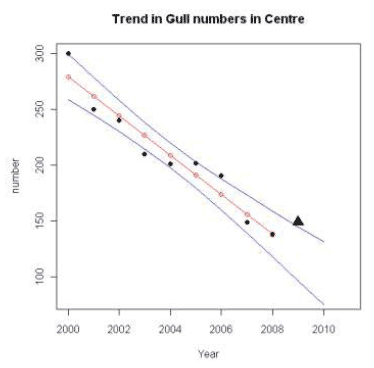
Solid points are the observed bird counts. Hollow points and the straight line are the linear modelled values. Outer lines are the 95% confidence intervals of the regression line. The 2009 actual count is represented by the black triangle (149 pairs). This falls out with the predicted values and confidence interval for this year and was higher than would be expected. Non-hunting falcons did not, therefore, result in a reduction in nesting gull population levels in the central area in 2009.
Of the 149 nests located within the central area, 138 were overflown by falcons operating within the Campaign Zone. This compared with 130 nests in 2008 thereby matching the increases recorded within the overall central area.
Table 2. Total Number of Nests Within and Outwith the Campaign Zone in 2008 and 2009. Count 1 Shows the Change in Numbers of Nests in the Campaign Zone. Count 2 Shows the Change in Nests Outwith this Zone.
Count Area |
Characteristic |
2008 |
2009 |
Percentage Change |
|---|---|---|---|---|
1 |
Campaign Zone |
130 |
138 |
+6.2% |
2 |
Control Zone |
168 |
215 |
+28.0% |
Total |
298 |
353 |
+18.5% |
Between 2008 and 2009 the numbers of breeding pairs of gulls increased in both areas by a mean of 18.5%; within the Campaign Zone by 6.2% and within the Control Zone by 28.0%.
The overall number of gulls sampled during the behavioural studies did not vary during regular censuses undertaken throughout the falconry period within the Campaign Zone (mean 90.5, SE 3.44, n = 247), or the Control Zone (mean 66.4, SE 2.21, n = 247). This suggests the breeding birds present at the outset of the study remained through to its completion.
Table 3. Mean No Gulls Sampled Within each Study Area.
Species |
Control Zone |
Campaign Zone |
||||
|---|---|---|---|---|---|---|
Mean |
Max |
Min |
Mean |
Max |
Min |
|
LBB |
46.7 |
114.7 |
18.9 |
61.9 |
87.5 |
34.2 |
HG |
19.7 |
31.6 |
14.1 |
28.6 |
43.6 |
12.6 |
Total |
66.4 |
146.3 |
3..0 |
90.5 |
131.1 |
46.8 |
Separate vantage point counts undertaken on the 14th April and the 15 th May also revealed little change in the number of large gulls present within the Campaign Zone from 112 birds to 97 birds. Anecdotal evidence suggested that sub-adult birds may have been displaced on arrival of the falcons into the area. Any reductions that could have occurred as the Campaign began were not, however, recorded as no data were provided from the pre-study period. Evidence that sub-adult birds were dispersed is present from the proportion data gathered for sub-adult and adult birds. In 2009, for example, only three out of every hundred breeding gulls in the Campaign Zone showed signs of immature plumage (repeat examination of same individuals on subsequent days could not be excluded). In contrast, twelve gulls with signs of immature plumage were found breeding in a similarly sized sample from the Control Zone. Similarly, no day roosts of gulls within the Campaign Zone occurred in 2009. Three of these areas, used by off-duty adults and young or prospecting individuals, were present in 2008 when falconry was not in place. Members of the public and the falconry company also perceived that an initial reduction in gull numbers was achieved at the outset of the study. This was not reflected in the data gathered during the course of the programme. (see appendix 1).
The presence of gulls within the townscape, however, varied significantly during each hour of the day ( Appendix 2). This was particularly prominent during the earlier weeks of the study as birds flew south and departed the area towards dusk. This occurred within both the Control and Campaign Zones, however, and suggests the departure was caused by roost behaviour not a displacement caused by the falconry.
Time of Laying
Time of laying was delayed by at least one week compared to any of the previous eight years (Coulson, pers comm.). This was consistent across the Campaign Zone, Control Zone and out-lying areas. It also ties in with a general trend reported across Scotland for later breeding of large gulls in 2009.
Gull Behaviour
The behaviour of gulls in response to falconry contrasted markedly between the Campaign and Control Zones. These data therefore provide a reference as to the direct impact falconry had. A total of 494 scan sample counts (247 in each Zone), were completed alongside 2432 minutes of observations of gull behaviour within the Control Zone, and 2591 within the Campaign Zone. All observations of feeding behaviour observed were recorded (69 minutes within the Campaign Zone and 42 minutes within the Control Zone).
The proportion of undisturbed (i.e. relaxed) behaviour recorded within the Control Zone was 61% for Lesser Black-backed Gulls and 79% for Herring Gulls. This declined to 51% and 74% respectively within the Campaign Zone. Observations over time, however, suggest a far greater impact occurred during the initial stages of the study after which gulls were observed gradually increasing their tolerance of falcons.
Impact of Falcons on Lesser Black-backed Gull Behaviour
Figure 3a - Comparative behaviour of Lesser Black-backed Gulls within the Campaign Zone.
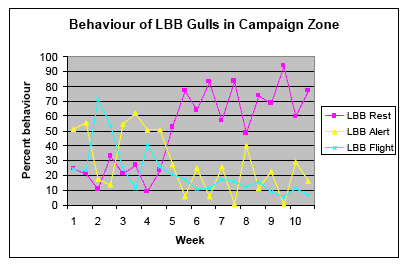
Figure 3b - Comparative behaviour of Lesser Black-backed Gulls within the Control Zone
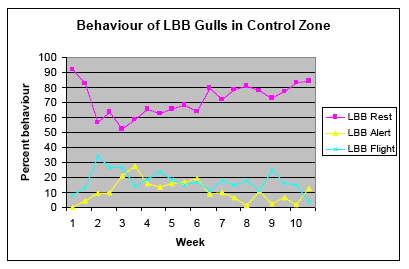
Lesser Black-backed Gulls exhibited more disturbed behaviour (alert + flight behaviour) during the first half of the study within the Campaign Zone than they did within the Control Zone (Mann Whitney U = 6.783, P< 0.001). A change in this behaviour occurred at the half way stage of the study after which there was no significant difference between the levels of disturbed behaviour exhibited between the Campaign and Control Zones (Mann Whitney U = 1.157, P = 0.247). Significantly more disturbed behaviour was observed during the first half of the study (weeks 1-5) than the second half of the study (weeks 6 - 10) within the Campaign Zone (Mann Whitney U = 3.044, P< 0.001). The key change in behaviour occurred during week 5 (ending Sunday 19 th April). This contrasted with the behaviour in the Control Zone where there was no change in the level of disturbed behaviour across the first and second halves of the study (Mann Whitney U = 1.451, P = 0.157).
Lesser Black-backed Gull Foraging Bouts
During foraging bouts (38 minutes in the Campaign Zone and 23 minutes in the Control Zone), no aggressive behaviour was observed being carried out by Lesser Black-backed Gulls. All foraging was targeted at discarded food waste on a streetscape or from children on a playing field during college breaks. Only one 'potentially' aggressive situation arose in the town centre from the 11 events recorded by the research team.
Impact of Falcons on Herring Gull Behaviour
Figure 4a - Comparative Behaviour of Herring Gulls Within the Campaign Zone.
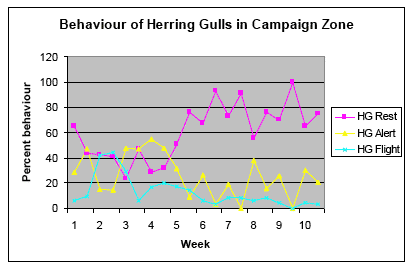
Figure 4b - Comparative Behaviour of Herring Gulls Within the Control Zone
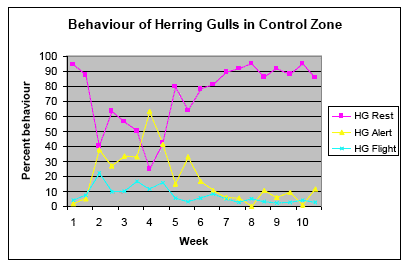
Herring Gull behaviour within the Campaign Zone appeared to be similar to that of Lesser Black-backed Gull behaviour. A significant difference was observed in disturbed behaviour (disturbed + flying) between the first and second halves of the study within the Campaign Zone (Mann Whitney U = 2.312, P < 0.05). This was mirrored, however, within the Control Zone (Mann Whitney U = 2.691, P < 0.001) and confirmed when no difference was observed in disturbed behaviour between the Campaign and the Control Zone during the first half of the study (Mann Whitney U = 0.920, P = 0.400). Territorial and courtship behaviour, thought to have been responsible for apparently disturbed behaviour records did not continue outside weeks 2 to 4 with the result that disturbance within the Control Zone had ceased by the latter half of the study. Greater levels of disturbed behaviour were therefore recorded within the Campaign Zone compared to the Control Zone (Mann Whitney U = 6.728, P < 0.001) in the latter half of the study. This suggests that falcons were causing disturbance throughout the study but it was masked by aggressive courtship and territorial behaviour observed during the first half of the study.
Herring Gull Foraging Bouts
During foraging bouts (31 minutes in the Campaign Zone and 19 minutes in the Control Zone), no aggressive behaviour towards man was observed. All but 8 minutes of foraging (one single Herring Gull feeding on worms in the Control Zone) was targeted at discarded food waste.
The overall behavioural differences recorded between the first (weeks 1 - 5) and second (weeks 6 - 10) periods of the study within the Control and Campaign Zones are summarised in Table 4 below.
Table 4. Summary of Gull Behaviours Observed During Study Period.
Species |
Campaign Zone weeks 1-5 |
Campaign Zone weeks 6-10 |
||||
|---|---|---|---|---|---|---|
Rest |
Disturbed |
Flight |
Rest |
Disturbed |
Flight |
|
LBB Ad |
38.4% |
19.9% |
40.9% |
58.7% |
23.9% |
15.2% |
HG Ad |
60.7% |
15.5% |
22.5% |
78. 8% |
12.7% |
8.0% |
Control Zone weeks 1 - 5 |
Control Zone weeks 6 -10 |
|||||
LBB Ad |
54.4% |
8.1% |
35.7% |
65.7% |
21.5% |
12.0% |
HG Ad |
73.3% |
8.5% |
12.4% |
85.4% |
13.1% |
1.5% |
Restful behaviour increased by approximately 20% between the first and second half of the study for both species of gulls within the Campaign Zone and by about 10% within the Control Zone. In all cases greater levels of flight plus disturbed behaviour and lesser levels of restful behaviour were observed in the Campaign Zone. The number of gulls present within the Campaign and Control Zones varied between study Zones and with time of day.
Gulls Taking Food
The attraction of gulls to food presented by the general public on the riverside and in the central shopping area (both within the Campaign Zone) was assessed. Food, deliberately dropped by the general public, or when such situations did not occur, by the observers, was rapidly collected by gulls that were typically standing on vantage points overlooking the streetscape. The numbers attending these food provisions declined by the end of the study.
Table 4. Mean Number of Gulls Attending Food Drops.
Date |
Number of gulls attending |
|---|---|
15-16 April |
9.3 (3) |
14-15 May |
5.3 (3) |
The total number of complaints from the public rose slightly during the study period from 4 "food stealing events" in 2008 to 6 swooping or food stealing events in 2009.
Contact
Email: Central Enquiries Unit ceu@gov.scot
There is a problem
Thanks for your feedback